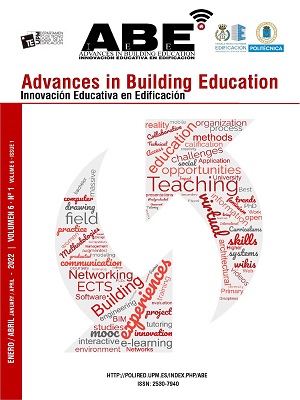Combining technical and business studies at the Universidad Politécnica de Madrid: Analysis of the Double Degree student profile
DOI:
https://doi.org/10.20868/abe.2022.1.4813Keywords:
Double Degree, Building, Business Administration and Management, interest, studentsAbstract
Double degrees have emerged as an attractive alternative for Spanish university students. The Double Degree in Building and in Business Administration and Management (EDIF-ADE) was a pioneer among the Double Degrees implemented at the Universidad Politécnica de Madrid (UPM) and is currently experiencing a great demand. This study analyses the profile of EDIF-ADE students to understand the keys to this success. Through a survey of first-, second-, third-, and fourth-year students, we examined (1) students’ prior knowledge; (2) motivations and interest areas; (3) educational and occupational expectations; (4) results and knowledge acquired. The results of the study reveal that, although most of the students had no prior knowledge of economics and business, they consider this training as an important element in their future professional development that enhances their employability prospects.Downloads
References
Ministerio de Industria, Energía y Turismo.Libro Blanco para el Dise-o de las TitulacionesUniversitarias en el Marco de la Economía Digital, 2015.
Knight, J. Doubts and Dilemmas with DoubleDegree Programs, in: De Wit (Ed)., Globalisationand Internationalisation of Higher Education.Revista de Universidad y Sociedad delConocimiento 8 (2011) 297-312.
ANECA. Catálogo titulaciones universidadesespa-olashttps://srv.aneca.es/ListadoTitulos/busqueda-titulaciones, 2021 (consultado el 17 de marzode2021)
UPM. Catálogo grados en la UPM.https://www.upm.es/FuturosEstudiantes/Estudios_Titulaciones/Estudios%20Oficiales%20de%20Grado, 2021 (consultado el 17 de marzo de2021)
UPM. Estudio de análisis y prospectiva deempleabilidad de los estudiantes y egresadospor la Universidad Politécnica de Madrid.https://www.upm.es/sfs/Rectorado/Vicerrectorado%20de%20Ordenacion%20Academica%20y%20Planificacion%20Estrategica/Inteligencia%20Institucional/fichas/informe_empleabilidad%20estudiantes%20y%20egresados%202019%20junio.pdf, 2019 (consultado el 17 de marzo de 2021)
Michavila, F., Martínez, J. M., Martín-González, M., García-Pe-alvo, F. J., Cruz-Benito, J. Barómetro de Empleabilidad y Empleode los Universitarios en Espa-a, 2015 (Primerinforme de resultados). Madrid: Observatorio deEmpleabilidad y Empleo Universitarios, 2016
Michavila, F., Martínez, J. M., Martín-González, M., García-Pe-alvo, F. J. y Cruz-Benito, J., Vázquez-Ingelmo, A. Barómetro deEmpleabilidad y Empleo Universitarios. EdiciónMáster 2017. Madrid: Observatorio deEmpleabilidad y Empleo Universitarios, 2018.
AQU. La empleabilidad y competencias de losrecién graduados: la opinión de empresas einstituciones. Agència per a la Qualitat del Sistema Universitari de Catalunya. Barcelona, 2015.
Russell, A.W., Dolnicar, S., Ayoub, M. Doubledegrees: double the trouble or twice thereturn?. High Educ (2008) 55, 575-591.https://doi.org/10.1007/s10734-007-9076-2 https://doi.org/10.1007/s10734-007-9076-2
Klapper, L., Lusardi, A.,Van Oudheusden, P.Financial Literacy around the World. WashingtonDC: Standard & Poor's Ratings Services GlobalFinancial Literacy Survey, 2015.
Ministerio de Ciencia Innovación yUniversidades Hechos y Cifras del SectorUniversitario Espa-ol, 2019.https://www.ciencia.gob.es/stfls/MICINN/Universidades/Ficheros/Estadisticas/datos-y-cifras-sue-2018-19.pdf. Consultado el 17/03/2021
ETSI Edificación. Informe académico de laTitulación, ANX-PR/ES/003-03. UniversidadPolitécnica de Madrid.https://www.edificacion.upm.es/images/INFORME_DE_LA_TITULACION_GE__ADE__2016-17.pdf 2018 (consultado el 15 de marzo de2021).
Yue, H., Fu, X. Rethinking Graduation andTime to Degree: A Fresh Perspective. Res HighEduc 58 (2017), 184-213.https://doi.org/10.1007/s11162-016-9420-4 https://doi.org/10.1007/s11162-016-9420-4
Hernández, P. Pastor, J.M. Característicassocioeconómicas de los estudiantes de nuevoingreso de la Universitat de València.Valencia: Universitat de valència. Centre de Formació i Qualitat Manuel Sanchis Guarner. Anejos de @tic. Volumen 1, 2011.
Fundación BBVA. Estudio internacionalFundación BBVA sobre estudiantesuniversitarios de seis países europeos, 2010.
Guerra, C., Rueda, E. Mª. Estudiolongitudinal de los jóvenes en el tránsito de laense-anza secundaria a la universidad:orientación, expectativas, toma de decisiones yacogida de los nuevos estudiantes en launiversidad. Estudio financiación del Programade Estudios y Análisis de la Secretaría de Estadode Universidades e Investigación del Ministeriode Educación y Ciencia, 2005.
Del Rossi, A., Hersch, J. The Private andSocial Benefits of Double Majors. Journal ofBenefit-Cost Analysis 7 (2016), 292-325.https://doi:10.1017/bca.2016.14 https://doi.org/10.1017/bca.2016.14
Del Rossi, A., Hersch, J. Double your major,double your return? Economics of EducationReview 27 (2008), 375-386,https://doi.org/10.1016/j.econedurev.2007.03.001. https://doi.org/10.1016/j.econedurev.2007.03.001
Simón, J.D. Yo estudio para ser ingeniero:¿para qué cursar administración y contabilidad?Propósitos y Representaciones 6 (2018), 453-540 http://dx.doi.org/10.20511/pyr2018.v6n2.227 https://doi.org/10.20511/pyr2018.v6n2.227
Downloads
Published
Issue
Section
License
ABE (Advances in Building Education / Innovación Educativa en Edificación) does not charge authors for processing or publishing an article and provides immediate Open Access to its content. All content is available free of charge to the user or his institution. Users are permitted to read, download, copy, distribute, print, search or link to the full text of articles, or use them for any other lawful purpose, without prior permission from the publisher or author. This is in accordance with the BOAI definition of open access.
- Authors retain the copyright and grant to the journal the right to a Creative Commons attribution / Non-Commercial / Non-Derivative 4.0 International (CC BY NC ND) License that allows others to share the work with an acknowledgement of authorship and non-commercial use.
- Authors may separately establish additional agreements for the non-exclusive distribution of the version of the work published in the journal (for example, placing it in an institutional repository or publishing it in a book).
Unless otherwise indicated, all contents of the electronic edition are distributed under a Creative Commons license.














